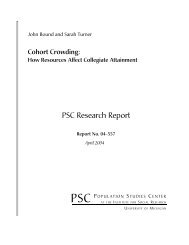Tracking metropolitan America into the 21st century - Population ...
Tracking metropolitan America into the 21st century - Population ...
Tracking metropolitan America into the 21st century - Population ...
Create successful ePaper yourself
Turn your PDF publications into a flip-book with our unique Google optimized e-Paper software.
Table 2. Number ofMicroSAs by StateRank State Micros1 Texas 412 Ohio 293 North Carolina 264 Indiana 255 Georgia 246 Illinois 237 Pennsylvania 218 Missouri 209 Mississippi 2010 Tennessee 2011 Michigan 1812 Minnesota 1813 Kentucky 1714 Louisiana 1715 Oklahoma 1716 Kansas 1517 New York 1518 Iowa 1519 Arkansas 1420 New Mexico 1421 Oregon 1322 South Carolina 1323 Wisconsin 1324 Alabama 1325 Florida 1126 Nebraska 1027 South Dakota 928 Washington 929 California 930 Idaho 831 Colorado 732 Wyoming 733 West Virginia 634 New Hampshire 635 Arizona 536 Montana 537 North Dakota 538 Vermont 539 Utah 540 Maryland 441 Nevada 442 Alaska 343 Hawaii 344 Virginia 345 Connecticut 246 Maine 247 Delaware 148 District of Columbia 049 Massachusetts 050 New Jersey 051 Rhode Island 0Source: OMBNote: Micropolitan areas that cross stateboundaries are counted once in each state.Frey (2004a) highlight <strong>the</strong> variationsin micropolitan area demographic profiles.They find that <strong>the</strong> fastest-growingMicroSAs are located nearby largegrowing MetroSAs, while <strong>the</strong> moreremote MicroSAs are generally smallerand slow-growing. Overall, MicroSApopulations tend to be older, poorer,more conservative, less educated, andless racially diverse than <strong>the</strong>ir <strong>metropolitan</strong>counterparts. 15C. Under <strong>the</strong> new system, 81 of <strong>the</strong>nation’s 102 largest <strong>metropolitan</strong>areas have undergone changes interritory and population.Analysts and even casual observersfirst encountering <strong>the</strong> new <strong>metropolitan</strong>areas will likely ask: How differentare <strong>the</strong> new standards from <strong>the</strong> oldones? The simple answer is: quite abit. The changes are especially pronouncedin <strong>the</strong> nation’s larger <strong>metropolitan</strong>areas, which form <strong>the</strong> focus ofmany Brookings Metropolitan PolicyProgram analyses. This section firstdescribes <strong>the</strong> changes from <strong>the</strong> old tonew systems at <strong>the</strong> county level, <strong>the</strong>nexplores how those county transitionsre-shaped <strong>the</strong> nation’s largest <strong>metropolitan</strong>areas.County ShiftsBecause both <strong>the</strong> old and new systemsare county-based, it is possible to view<strong>the</strong> extent of change between <strong>the</strong> twosystems from <strong>the</strong> county level. Between<strong>the</strong> systems, counties could make sixpossible transitions, shown in Table 3.Of <strong>the</strong> 3,141 counties that make up<strong>the</strong> United States, a plurality (43 percent)remained “undefined”—that is,<strong>the</strong>y were non-<strong>metropolitan</strong> under <strong>the</strong>old system and are non-core-basedunder <strong>the</strong> new system. They include<strong>the</strong> vast number of small, rural countiesfound mostly in <strong>the</strong> interior states.The next largest proportion of counties(26 percent) remained <strong>metropolitan</strong>between <strong>the</strong> old and new systems, andof <strong>the</strong>se <strong>the</strong> vast majority (92 percent)remained within <strong>the</strong> same <strong>metropolitan</strong>area. So roughly 70 percent ofcounties retained a comparable classificationin <strong>the</strong> transition to <strong>the</strong> newstandards.O<strong>the</strong>r counties changed classificationdue to <strong>the</strong> introduction of <strong>the</strong>micropolitan concept, new rules fordefining <strong>metropolitan</strong> areas, changesin commuting patterns, or simple populationgrowth and decentralization.Counties that changed from non-<strong>metropolitan</strong>to micropolitan were fairlycommon, accounting for 21 percentof all counties and nearly 10 percentof U.S. population. Nine percent ofU.S. counties jumped from non-<strong>metropolitan</strong>to <strong>metropolitan</strong> status. Farsmaller proportions moved down <strong>the</strong>hierarchy from <strong>metropolitan</strong> tomicropolitan (1 percent) and from<strong>metropolitan</strong> to non-core-based status(just 5 counties).As a result of <strong>the</strong>se transitions, agreater share of <strong>the</strong> nation’s populationis now considered <strong>metropolitan</strong>(83 percent, up from 80 percent). Onnet, 242 counties moved from non<strong>metropolitan</strong>to <strong>metropolitan</strong> standing(46 from <strong>metropolitan</strong> to non-<strong>metropolitan</strong>and 288 from non-<strong>metropolitan</strong>to <strong>metropolitan</strong>). Some becamepart of <strong>the</strong> 44 new <strong>metropolitan</strong> areasannounced under <strong>the</strong> new system,while o<strong>the</strong>rs were added onto <strong>the</strong>fringe of existing <strong>metropolitan</strong> areas.Of <strong>the</strong> 46 counties that changed statusfrom <strong>metropolitan</strong> to non-<strong>metropolitan</strong>,only five did not becomepart of a MicroSA. The 41 previously<strong>metropolitan</strong> counties that becamemicropolitan did not necessarily shrinkin size, but generally failed to meet<strong>the</strong> new more stringent commutingthreshold for inclusion in <strong>metropolitan</strong>areas.Metropolitan ShiftsDespite <strong>the</strong> fact that a majority of <strong>the</strong>nation’s counties have effectively <strong>the</strong>same designations under <strong>the</strong> new system,<strong>the</strong> county composition of most of<strong>the</strong> nation’s largest <strong>metropolitan</strong> areaschanged in some way. In fact, 81 of <strong>the</strong>102 <strong>metropolitan</strong> areas with popula-The Living Cities Census Series















